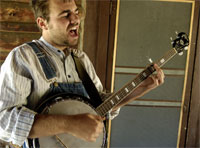Make your own banjo
 Banjos were first brought to America by African slaves in the late 17th century, and their music became part of the culture of the South. Much of the South was settled by Scottish and Irish immigrants, and they brought their musical traditions of Celtic fiddle songs with them, as well.
Banjos were first brought to America by African slaves in the late 17th century, and their music became part of the culture of the South. Much of the South was settled by Scottish and Irish immigrants, and they brought their musical traditions of Celtic fiddle songs with them, as well.
The mixture of the two brought about the musical traditions that have become uniquely American, including the blues, bluegrass, country, ragtime and Dixieland.
Here’s how you can make music with a simple banjo of your own:
WHAT YOU’LL NEED
- large plastic container (2 to 4 quart)
- scissors
- 30-by-1-by-2-inch wood strip
- hammer
- two 1-inch nails
- 2 screw eyes
- 3 yards nylon fishing line
- two, 3/4-by-2-by-1/4-inch pieces of wood
- saw
- sandpaper
WHAT YOU’LL DO
 Step 1: Cut off the top half of the plastic container. Discard the top. Cut two trap-door flaps on opposite sides of the container. These flaps should be about one inch above the bottom of the container and about the size of the wood strip, which will be the “neck” of the banjo. Slip the wood strip through the trap doors; the fit should be fairly tight.
Step 1: Cut off the top half of the plastic container. Discard the top. Cut two trap-door flaps on opposite sides of the container. These flaps should be about one inch above the bottom of the container and about the size of the wood strip, which will be the “neck” of the banjo. Slip the wood strip through the trap doors; the fit should be fairly tight.
Step 2: Hammer the nails in side by side at the very end of the neck of the banjo on the end closer to the container. Only about 1/4 inch of the nails should be showing. Next screw the screw eyes into the opposite end of the neck, leaving them partially unscrewed (you will tighten them later).

Step 3: Tie pieces of the fishing line between the nails and screw eyes, and knot them so that they are very secure.
Step 4: Take one of the smaller pieces of wood (this piece will make the “bridge”) and insert it under the strings at the point where the strings cross the center of the bottom of the plastic container. Cut string-size grooves in the bridge so that the strings can sit securely on the bridge.

Step 5: Place the other small pieces of wood under the strings next to the screw eyes. This will give the strings extra tension. In order to tighten the strings, screw the screw eyes in tighter. Strings should be tight for maximum resonance.
Project adapted from “Great Civil War Projects You Can Build Yourself” by Maxine Anderson, published by Nomad Press.
wow thats cool
that is a awsome banjo
This reallly works its so cool im going to start my own skiffle band.
you can also use a gourd, and some rawhide stretched over the gourd, and buy some real banjo strings, and make frets out of pieces of wire.
it looks really cool and all, but what about frets? you could use paper clips.
im gonna make one
Insted of a container use the bottom 3in. of a plastic bucket.Then just cut that off and just do the same thing shown in the directons.Has a lot more sound and looks alot cooler.Insted of two strings put 4 or 6 on.Just like a real banjo.If you want more info just reply
well i would want do one but it is to big to take to school sorry
greg’o how do i go about putting 4-6 strings on the banjo instead of just having two?
hey yeah same question, should i just put more screw eyes at the top?
I’m trying to make a banjo similar to this for a physics project. one problem I have found is that the strings are really high off the neck, because of the bridges and plastic bucket. Also, what did you use for the plastic bucket. I’m trying an ice cream pal and It seems to work fine but the sound isn’t very loud. Finally do you know if adding frets will increase the intensity of the sound. Thank you for anything you can help me with.
Adding frets would not impressive the intensity of the sound, but it would make your playing more accurate. I play a 5 string banjo and I also have a fretless. There is no sound difference. Best of luck with your school project.
real banjos have 5 strings
AWSOME, I’ll try it.
nice , i might try that out
awsome way to make a banjo